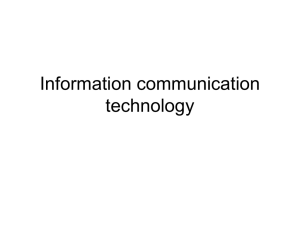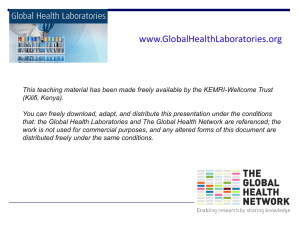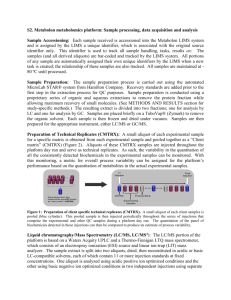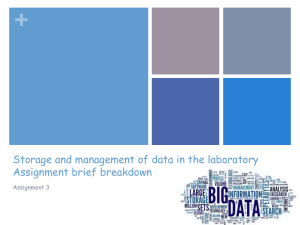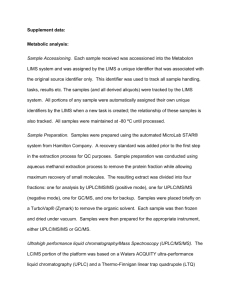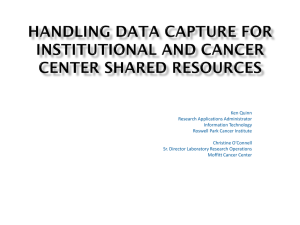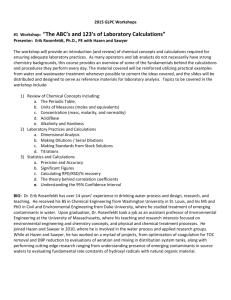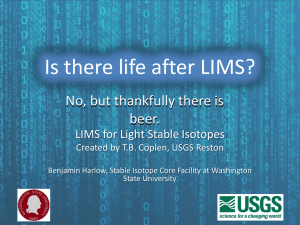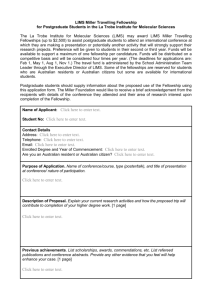Preparing the Project Management plan
advertisement
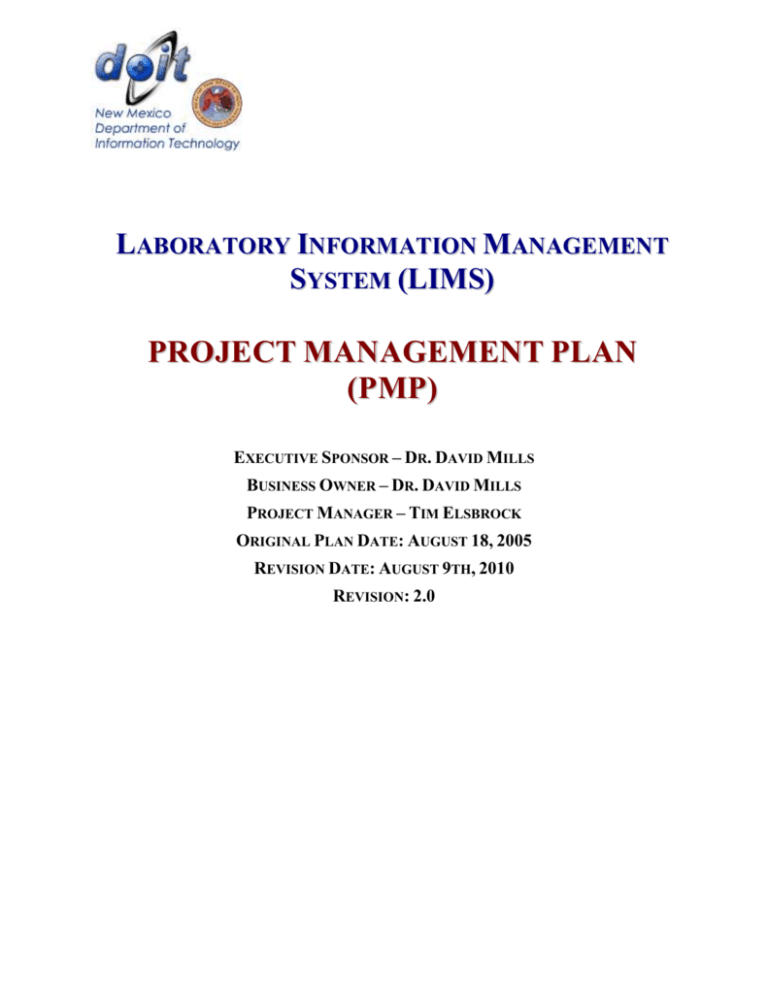
LABORATORY INFORMATION MANAGEMENT SYSTEM (LIMS) P R O JE C T M A N A GEM E N T PLA N (PMP) EXECUTIVE SPONSOR – DR. DAVID MILLS BUSINESS OWNER – DR. DAVID MILLS PROJECT MANAGER – TIM ELSBROCK ORIGINAL PLAN DATE: AUGUST 18, 2005 REVISION DATE: AUGUST 9TH, 2010 REVISION: 2.0 PROJECT MANAGEMENT PLAN FOR [PROJECT NAME] REVISION HISTORY................................................................................................................................................ III PREPARING THE PROJECT MANAGEMENT PLAN ................................................................................................... IV ABOUT THIS DOCUMENT ...................................................................................................................................... IV PROJECT OVERSIGHT PROCESS MEMORANDUM – DOIT, JULY 2007 ................................................................. IV 1.0 PROJECT OVERVIEW ......................................................................................................................................... 1 1.1 Executive Summary- rationale for the Project ................................................................................................1 1.2 funding and sources .......................................................................................................................................2 1.3 Constraints .....................................................................................................................................................2 1.4 Dependencies .................................................................................................................................................3 1.5 Assumptions ...................................................................................................................................................4 1.6 Initial Project Risks Identified ........................................................................................................................4 2.0 PROJECT AUTHORITY AND ORGANIZATIONAL STRUCTURE .............................................................................. 6 2.1 Stakeholders ...................................................................................................................................................6 2.2 Project Governance Structure ........................................................................................................................6 2.2.1 Describe the organizational structure – Org Chart .....................................................................................6 2.2.2 Describe the role and members of the project steering committee ............................................................7 2.2.3 Organizational Boundaries, interfaces and responsibilities ........................................................................7 2.3 Executive Reporting ........................................................................................................................................8 3.0 SCOPE .............................................................................................................................................................. 9 3.1 Project Objectives ............................................................................................ Error! Bookmark not defined. 3.1.1 Business Objectives .....................................................................................................................................9 3.1.2 Technical Objectives ..................................................................................................................................10 3.2 Project Exclusions .........................................................................................................................................10 3.3 Critical Success Factors .................................................................................................................................11 4.0 PROJECT DELIVERABLES AND METHODOLOGY ............................................................................................... 11 4.1 Project Management Life Cycle ....................................................................................................................11 4.1.1 Project Management Deliverables ............................................................................................................12 4.1.2 Deliverable Approval Authority Designations ...........................................................................................13 4.1.3 Deliverable Acceptance Procedure ............................................................................................................14 4.2 Product Life Cycle .........................................................................................................................................14 4.2.1 Technical Strategy .....................................................................................................................................15 4.2.2 Product and Product Development Deliverables .......................................................................................15 4.2.3 Deliverable Approval Authority Designations .............................................. Error! Bookmark not defined. 4.2.4 Deliverable Acceptance Procedure ............................................................................................................17 5.0 PROJECT WORK .............................................................................................................................................. 17 5.1 Work Breakdown Structure (WBS) ...............................................................................................................17 5.2 Schedule allocation - Project Timeline ..........................................................................................................18 5.3 Project Budget ..............................................................................................................................................20 5.4 Project Team ................................................................................................................................................20 5.4.1 Project Team Organizational Structure .....................................................................................................20 5.4.2 Project Team Roles and Responsibilities ...................................................................................................21 5.5 STAFF PLANNING AND Resource ACQUISITION ............................................................................................22 5.5.1 Project Staff ...............................................................................................................................................22 5.5.2 Non-Personnel resources ...........................................................................................................................23 5.6 PROJECT LOGISTICS ......................................................................................................................................24 REVISION: 1.0 DOIT-PMO-TEM-020 i OF vi PROJECT MANAGEMENT PLAN FOR [PROJECT NAME] 5.6.1 Project Team Training ...............................................................................................................................24 6.0 PROJECT MANAGEMENT AND CONTROLS ...................................................................................................... 25 6.1 Risk and issue Management ........................................................................................................................25 6.1.1 Risk Management Strategy .......................................................................................................................25 6.1.2 Project Risk Identification ..........................................................................................................................25 6.1.3 Project Risk Tracking Approach .................................................................................................................25 6.1.4 ISSUE MANAGEMENT ................................................................................................................................26 6.2 INDEPENDENT Verification and Validation - IV&V .......................................................................................27 6.3.1 Change Control ..........................................................................................................................................27 6.4 Project Budget Management .......................................................................... Error! Bookmark not defined. 6.4.1 Budget Tracking ........................................................................................... Error! Bookmark not defined. 6.5.1 Communication Matrix .............................................................................................................................29 6.5.2 Status Meetings ........................................................................................................................................29 6.5.3 Project Status Reports ...............................................................................................................................29 6.6 PERFORMANCE MEASUREMENT (PROJECT METRICS) .................................................................................29 6.6.1 Baselines....................................................................................................................................................29 6.7 QUALITY OBJECTIVES AND CONTROL ............................................................................................................. 29 6.7.1 quality Standards ......................................................................................................................................30 6.7.2 Agency/Customer Satisfaction ..................................................................................................................31 6.7.3 PRODUCT DELIVERABLE ACCEPTANCE PROCESS .......................................................................................32 6.8 CONFIGURATION MANAGEMENT .................................................................................................................. 32 6.8.1 Version Control ..........................................................................................................................................32 6.8.2 Project Repository (Project Library) ...........................................................................................................33 6.9 PROCUREMENT MANAGEMENT PLAN............................................................................................................ 33 7. 0 PROJECT CLOSE ............................................................................................................................................. 33 7.1 Administrative Close .....................................................................................................................................34 7.2 Contract Close ..............................................................................................................................................34 REVISION: 1.0 DOIT-PMO-TEM-020 ii OF vi PROJECT MANAGEMENT PLAN FOR [PROJECT NAME] REVISION HISTORY REVISION NUMBER DATE COMMENT 1.0 July 27th, 2007 DoIT Project Management Office Revision 2.0 August 9th Recertification for $195K of additional funds 2.1 2.2 REVISION: 1.0 DOIT-PMO-TEM-020 iii OF vi PROJECT MANAGEMENT PLAN FOR [PROJECT NAME] PREPARING THE PROJECT MANAGEMENT PLAN The workbook for preparation of the Project Management Plan is built around helping the project manager and the project team to use the Project Management Plan in support of successful projects. Please refer to it while developing this PMP for your project. ABOUT THIS DOCUMENT Project Oversight Process Memorandum – DoIT, July 2007 “Project management plan” is a formal document approved by the executive sponsor and the Department and developed in the plan phase used to manage project execution, control, and project close. The primary uses of the project plan are to document planning assumptions and decisions, facilitate communication among stakeholders, and documents approved scope, cost and schedule baselines. A project plan includes at least other plans for issue escalation, change control, communications, deliverable review and acceptance, staff acquisition, and risk management. “Project manager” means a qualified person from the lead agency responsible for all aspects of the project over the entire project management lifecycle (initiate, plan, execute, control, close). The project manager must be familiar with project scope and objectives, as well as effectively coordinate the activities of the team. In addition, the project manager is responsible for developing the project plan and project schedule with the project team to ensure timely completion of the project. The project manager interfaces with all areas affected by the project including end users, distributors, and vendors. The project manager ensures adherence to the best practices and standards of the Department. Project product” means the final project deliverables as defined in the project plan meeting all agreed and approved acceptance criteria. “Product development life cycle” is a series of sequential, non-overlapping phases comprised of iterative disciplines such as requirements, analysis and design, implementation, test and deployment implemented to build a product or develop a service. REVISION: 1.0 DOIT-PMO-TEM-020 iv OF vi PROJECT MANAGEMENT PLAN FOR [PROJECT NAME] 1.0 PROJECT OVERVIEW 1.1 EXECUTIVE SUMMARY- RATIONALE FOR THE PROJECT The New Mexico Department of Health’s Scientific Laboratory Division (SLD) currently utilizes a number of stand-alone applications and data sets to meet its laboratory information system needs. The current systems utilize a combination of manual processes and electronic technologies. The SLD is receiving increasing demands from regulatory agencies, key clients and partners to modernize its information systems. Necessary functionality, such as required electronic reporting formats, privacy controls, electronic data exchange with clients and regulatory agencies (Centers for Disease Control, Environmental Protection Agency), internal tracking of specimens, and the ability to collect and analyze required quality assurance data, is not currently in place. The ability to manage the entire SLD operation from one computer screen, in a holistic manner is impossible under the current IT infrastructure, as the current information management system is based upon a laboratory section-by-laboratory section “ledger system” (lab section-specific listing of specimens) that is merely an electronic version of the paper-based recording system used by the laboratory 20 years ago. In the current system, specimens are only viewable and can only be queried from within each ledger. SLD receives more than 150,000 samples a year that result in over 700,000 unique test results. In the existing system, all of these samples are managed by a numeric identifier that has to be manually entered multiple times, i.e. each time an analyst enters or retrieves information on a sample. The LIMS implementation will result in a barcode system whereby samples will be traceable through the entire lab with a single pass of the work order by a barcode reader or by a single query. The current silo structure will be eliminated so that the location and status of a sample will be viewable by a single query. This increased capability will significantly augment the business processes within the laboratory by enabling management to monitor processes and turnaround times and also to track workloads for the laboratory’s numerous clients. The latter will indirectly facilitate SLD billing processes and increase accountability to DOH administration and the legislature by improving the accuracy of performance measures. The LIMS implementation will also enhance the electronic data transfer capabilities between SLD and its clients, allowing data transfer directly in formats required by clients, e.g. HL 7 messaging and Safe Drinking Water Information System (SDWIS) formats. Currently, data are transferred in flat files and must be manually converted to required formats. Since the project was originally certified, the LIMS project has reviewed the COTS products currently on the market, performed extensive analysis of current and desired business processes, generated detailed system requirements, issued an RFP, and is currently in contract negotiations with the selected vendor. 9/10 UPDATE: SLD is organized into four Bureaus: Sample Receiving, Biology, Toxicology/Implied Consent, and Chemistry. The LIMS project has been successfully rolled out across three of these four bureaus including: Sample Receiving, Biology, Toxicology and Implied Consent. Additionally, the LIMS has been successfully implemented in half of the Chemistry Bureau. The remaining half of the Chemistry Bureau consisting of the; Heavy Metals section, Water Chemistry section, and Organic Chemistry section, has yet to be completed. These sections will be completed by adding a Phase 5. Adding this additional phase was required for the following reasons: During the original contract negotiations and in an effort to reduce the overall cost of the system, the SLD removed some requirements that at time were thought to be satisfied by PAGE | 1 PROJECT MANAGEMENT PLAN FOR [PROJECT NAME] a workaround. Specifically, these requirements had to do with the use of spreadsheets used to perform extensive analytical and quality control-related calculations. As we moved through the lab with the LIMS implementation, and attained a grasp of how efficiencies can be gained through the use of such a unified system, it became apparent that we would need to integrate the functions performed by these spreadsheets into the LIMS. To further complicate matters, the SLD move to the recently completed New Mexico Scientific Laboratories Building was pending. To achieve the objectives of the project and still be able to fully utilize the available funding while the SLD moved to the new 180,000 square foot facility, half of the Chemistry section was removed from the Phase 4 scope of work and a LIMS upgrade to Version 6 was substituted. This upgrade was applied to all bureaus that went live in Phase 1, Phase 2, and Phase 3. Phase 4 was configured in LabWare LIMS Version 6 (all future configuration work will be in Version 6). The LIMS project has been successful in attaining the required funding for Phase 5. We have $75,000 of support from Epidemiology and Response Division Lab Capacity grant, and have also received a $120,000 grant award from the Environmental Protection Agency. With this money the contract will be amended to reflect the Phase 5 deliverables that will enable the SLD to complete the LIMS. Phase 5 implementation will start once the lab has completed the move into the new building. A move date has been set for September 16th. It is expected that the move will cause considerable disruption to lab operations for at least one month after this date. Phase 5 is currently slated to start in November. 1.2 FUNDING AND SOURCES APPROPRIATION HISTORY (INCLUDE ALL FUNDING SOURCES, E.G. FEDERAL, STATE, COUNTY, MUNICIPAL LAWS OR GRANTS) Amount Funding Source(s) FY06 $1,000,000 $1,000,000 - Laws 2005, Chapter 33, Section 7, Subsection 23 FY07 $108,550 $108,550 – Preparedness and Response to Bioterrorism Grant (CDC Cooperative Agreement U90/CCU61699905) FY08 $446,436 $217,436 – Scientific Laboratory Division Operating Budget – Laws 2007, Chapter 28, Section 4, Subsection F, DOH, Paragraph 3 $229,000 Preparedness and Response to Bioterrorism Grant (CDC Cooperative AgreementU90/CCU61699905) Fiscal Year PAGE | 2 PROJECT MANAGEMENT PLAN FOR [PROJECT NAME] FY10 $325,000 $325,000 – Scientific Laboratory Division Operating Budget – Laws 2007, Chapter 28, Section 4, Subsection F, DOH, Paragraph 3 FY11 $195,000 $120K from EPA Information Network Grant (EPA FY 2010 Exchange Network -OEI-10-01) $75K from Lab Capacity Grant (CDC Cooperative Agreement CDC- 5U50/CI623779) 1.3 CONSTRAINTS Constraints are factors that restrict the project by scope, resource, or schedule. NUMBER DESCRIPTION 1 Scope of the LIMS is constrained to workflow and process automation for the handling of samples and subsequent analysis. 2 Configuration of the LIMS post implementation will be constrained by available IT resources. While the initial implementation will address core workflow improvement, future configuration will have to be prioritized by the Change Control Board. 3 Since the project is ~80% complete, current scope is constrained to configuration work in the environmental testing component of the SLD to include: Heavy Metals, Organic Chemistry, and Water Chemistry. 1.4 DEPENDENCIES Types include the following and should be associated with each dependency listed. Mandatory dependencies are dependencies that are inherent to the work being done. D- Discretionary dependencies are dependencies defined by the project management team. This may also encompass particular approaches because a specific sequence of activities is preferred, but not mandatory in the project life cycle. E-External dependencies are dependencies that involve a relationship between project activities and non-project activities such as purchasing/procurement NUMBER DESCRIPTION TYPE M,D,E 1 Project dependent on agreed price, terms, timelines between Agency and Vendor M 2 Project dependent on budgetary resources being carried over from FY08 to FY09 D PAGE | 3 PROJECT MANAGEMENT PLAN FOR [PROJECT NAME] NUMBER DESCRIPTION TYPE M,D,E 3 Project timeline dependent on schedule of Vendor E 4 Project is dependent on EPA grant of $120K, notice of grant award has been received. M 1.5 ASSUMPTIONS Assumptions are planning factors that, for planning purposes, will be considered true, real, or certain. NUMBER DESCRIPTION 1 The Scientific Laboratory Division of the State of New Mexico Department of Health will secure adequate funding for the planning, execution, and implementation of the LIMS. 2 The LIMS project will procure the services of a third-party to perform the project scope of work and implementation 1.6 INITIAL PROJECT RISKS IDENTIFIED Description – Probability: Expected User acceptance of LIMS workflow Mitigation Strategy : Heavy user training, translation of existing tables where possible, executive leadership stressing importance of user acceptance Contingency Plan : Retraining of users, increase training on code translations from old system to new system, rework LIMS configuration options to make reasonable accommodations to justifiable concerns Probability: Likely Impact: Medium Description – Misunderstood requirements Description - Adequate PAGE | 4 Impact : HIGH Mitigation Strategy: Currently working with selected LIMS vendor before contract negotiations are complete. Contingency Plan: SLD is bringing the LIMS administrators (primary and backup) into ALL committee meetings and technical discussions upfront to have technical understanding of each requirement. There is also $100,000 of funding in current budget that could be used for System configuration post implementation. Probability: Likely Impact : Medium PROJECT MANAGEMENT PLAN FOR [PROJECT NAME] Funding Description - Internal staffing issues Description – Insufficient network capacity Description - Technical Dependencies PAGE | 5 Mitigation Strategy: SLD is aware of tight budget through project completion. Executive sponsor has spent time considering various streams of funding to cover what would be a small shortfall within a project with a $2M total budget Contingency Plan: Reduce consulting work at final implementation phase; bring in more configuration work for SLD administrators. Postpone some instrument interface configurations with environmental systems until SLD moves into new building. There are several ways to cover the shortfall which will be small should it even materialize. Moreover, all assumptions to date are based on no expansion of SLD operating budget. Probability: Unlikely Impact : Medium Mitigation Strategy: SLD will make all changes to LIMS under a change control process. Required configurations will be generated from the bench level working analysts and pushed into the change control process for authorization. Contingency Plan: There will be two administrators at SLD that are trained to perform the full admin role, should one have to be replaced. Additionally, the LIMS PM will also end up as a trained admin. Additional training will be available in case of staff turnover.. Probability: Likely Impact : Medium Mitigation Strategy: ITSD is conducting a Network Assessment to confirm existing bandwidth capacity is sufficient to support expected LIMS response times. Contingency Plan: Network Assessment will provide recommendations which will be implemented in coordination with DoIT to mitigate this risk. Probability: Likely Impact : Medium Mitigation Strategy: The lab will increasingly depend on communication protocols into and out of the LIMS. To mitigate, one of each known protocol will be implemented. Contingency Plan: Protocols and technical dependencies expected to arise will be accommodated within the support plan. Will attempt to work on each known protocol during implementation. Also working with major state and federal interfaces that will be looking for SLD data feeds as way to get such protocols functionally in place. Much of this is still under development by the external parties. PROJECT MANAGEMENT PLAN FOR [PROJECT NAME] 2.0 PROJECT AUTHORITY AND ORGANIZATIONAL STRUCTURE The Project Organization describes the roles and responsibilities of the project team. It also identifies the other organizational groups that are part of the project and graphically depicts the hierarchical configuration of those groups. It exists to clarify interaction with the project team. 2.1 STAKEHOLDERS NAME OR TITLE STAKE IN PROJECT ORGANIZATION David Mills Scientific Laboratory Division Director Scientific Laboratory Division SLD Management Lab Operations Scientific Laboratory Division Regulatory Agencies Oversight of Laboratory Environmental Protection Agency (EPA), Food and Drug Administration (FDA) DOH Programs More Timely Results Department of Health Other Clinical Labs More Timely Ordering And Results SED, Tricore, Etc. Healthcare Providers More Timely Ordering And Results Various CDC More Timely Reporting Center for Disease Control Citizens Of NM More Timely Health Action New Mexico 2.2 PROJECT GOVERNANCE STRUCTURE 2.2.1 DESCRIBE THE ORGANIZATIONAL STRUCTURE – ORG CHART PAGE | 6 PROJECT MANAGEMENT PLAN FOR [PROJECT NAME] IV&V Contractor David Mills Executive Project Sponsor DOH LIMS Steering Committee Project Director Twila Kunde Tim Elsbrock Project Manager Business Process Team Technical Team 2.2.2 DESCRIBE THE ROLE AND MEMBERS OF THE PROJECT STEERING COMMITTEE The Steering Committee is chartered to provide governance over the direction and support of the project and is chaired by the Project Director. The Steering Committee member responsibilities include: Attend and participate in meetings Review and accept deliverables Review presented documentation Balance larger picture versus details of project Review project funding and expenditures Champion the project Contribute to lessons learned 2.2.3 ORGANIZATIONAL BOUNDARIES, INTERFACES AND RESPONSIBILITIES Use this section to describe any special considerations regarding contact between the project team, the project manager, and individuals from various organizations involved in the project: Boundary, interface and responsibilities at the interface Deliverable/Description Target PAGE | 7 Delivery Frequency Responsible PROJECT MANAGEMENT PLAN FOR [PROJECT NAME] Audience Method Party Monthly DOH Status DOH CIO Face-toFace Monthly/Upon Request CDC BT Grant Project Status Funding Source Written Quarterly/Upon Project Request Director/Project Manager Weekly Project Status Project Team Email/Face- Weekly Members/Project to-Face Director Project Team Members Project Team Meeting Project Team Face-toMembers/Project Face director Weekly Project Team Members/Project Manager Steering Committee Meeting Committee Members Face-toFace Monthly Project Director Ad hoc As needed As needed As needed As needed Monthly Department of Information Technology project reports Department of Information Technology FTP Monthly Project Manager Project Manager 2.3 EXECUTIVE REPORTING Meeting agendas, minutes, and supporting documentation will be provided using the following software packages: Microsoft Word, Excel, PowerPoint, Outlook and Project. Every attempt will be made to publish the meeting minutes in a timely fashion and no later than 2 days prior to the next regularly scheduled meeting. Any meeting called should have an agenda, attempt to start on time and finish on time. The time allocated to each agenda topic will vary depending on the depth of issues to be covered. Items not able to be covered within the meeting time and accepted to be postponed may be added to the next standing meeting’s agenda or may require a special session. The meeting times and distributions of the meeting minutes for the LIMS Project are as follows: Project Team Meetings will be on a regular schedule. The scribe will be assigned by the Project Manager. The project team meetings will be posted in the paper-based and electronic document libraries by the Project Manager. Monthly Steering Committee Meetings will continue to be held every month. The scribe will be assigned by the Project Director. The Monthly Steering Committee meeting minutes will be posted to the electronic document library in the LIMS Project folder and e-mailed to attendees. Special Session Meetings may be called at the request of the Project Director or Project Manager. A range of issues may require a special meeting of a team, committee or subset. These meetings will be scheduled to accommodate the majority of attendees. The minutes from PAGE | 8 PROJECT MANAGEMENT PLAN FOR [PROJECT NAME] these meetings will be posted in the document library and possibly e-mailed depending on the location of the attendees. Status reports will be used to track progress and issues. The Project Manager will provide bimonthly project status reports to the LIMS Project Director, and Steering Committee. Project Team members will provide status reports as requested by the Project Manager. These reports will be in addition to such reports prepared upon request and by other contractors. Special reports will be provided at the request of the LIMS Project Management Contract Administrator or the Project Director. Deliverable sign-offs will be used for approval purposes and will be archived in the physical project library in the Project Manager’s office. Issue management and resolution helps to resolve those issues not anticipated during planning process. Issues should be reported at the earliest possible time so that corrective action can be developed to deal with the issue. The corrective action should address both the immediate need and the underlying cause of the issue. The Project Manager will keep an issue tracking log and will work with the Project Team for corrective action. The Project Manager will maintain an action item list. This action item list identifies the action item, reference item, responsible party, solution, due date, and completion date. Updates may also be reflected in meeting minutes. 3.0 SCOPE 3.1.1 BUSINESS OBJECTIVES Business Objective 1 Description Compliance with Federal regulations and industry standards as dictated by Clinical Laboratory Improvement Act (CLIA), Health Insurance Portability and Accountability Act of 1996 (HIPAA), and the Environmental Protection Agency (EPA). Rationale Mandated by multiple parties that regularly interact with SLD Acceptance Criteria HL7 interface functioning by end of FY09 Business Objective 2 Description Ability to manage all lab sample submissions and reporting from within a single system Rationale Efficient management will improve overall SLD operations PAGE | 9 PROJECT MANAGEMENT PLAN FOR [PROJECT NAME] Acceptance Criteria 100% of submission can be tracked through entire lab within one application interface Business Objective 3 Description Ability to utilize technology across the entire lab as SLD completes the new building in 2011 Rationale Ability to integrate rooms, environmental, and testing equipment will be available for the move into the $90M building. SLD should break ground in FY08. Acceptance Criteria That integration of environmental systems by end FY09 Description Consolidation and the decommissioning of servers running the disparate databases that now exist across SLD. Rationale Cost and resources savings, Mandated by DoIT Acceptance Criteria Servers to be replaced will come off line one replacement functionality has been tested and put into production. 3.1.2 TECHNICAL OBJECTIVES OBJECTIVE DESCRIPTION Enable digital audit trail and Chain of Custody Allows lab to report on; sample handling, calibrations, analyst performing the tests, sample location. This is all done manually today. Enable web access to results The LIMS will allow SLD to communicate with partners via the web. Will also allow individuals to access their results remotely via the web. Manage all samples via barcode Reduce repetitive data entry by utilizing barcodes for every sample 3.2 PROJECT EXCLUSIONS The LIMS is a system designed specifically to handle sample submission and tracking. The LIMS is not design to handle operational activities across the lab such as: Inventory management of supplies not directly related to tests Scheduling of workforce or resources Facility resources management PAGE | 10 PROJECT MANAGEMENT PLAN FOR [PROJECT NAME] Specimen security concerns outside of audit trail 3.3 CRITICAL SUCCESS FACTORS NUMBER DESCRIPTION 1 All samples entering the SLD are entered into the LIMS, have barcodes applied, are traceable throughout the SLD, and have results generated automatically. 2 LIMS system is compatible with the data standards of the SLD’s partners 4.0 PROJECT DELIVERABLES AND METHODOLOGY 4.1 PROJECT MANAGEMENT LIFE CYCLE Phase Summary of Phase Key Deliverables Initiation Develop scope and high level objectives of project Business Case, Project Charter Planning Development of what a successful project looks like. Requirements document that translates functional tasks into product requirements. Selection of vendor to meet the defined requirements. Project Management Plan, Product requirements, ‘as is’ and ‘to be’ workflow diagrams for each section within the SLD, RFP Implementation Execute contract with vendor to fulfill the product requirements. Define development, test and acceptance criteria and execute. Contract with vendor, work plan, system testing and acceptance. Implement the LIMS throughout SLD. System enters production. Creation of Change Control Board (CCB) Closeout Document requirements are fulfilled by product, system has entered production and ownership transferred to Application Support Bureau (ASB), lessons learned. Application Support Plan (ASP) is completed and accepted. CCB takes control of configuration request prioritization. PAGE | 11 PROJECT MANAGEMENT PLAN FOR [PROJECT NAME] 4.1.1 PROJECT MANAGEMENT DELIVERABLES Project Deliverables are work products or artifacts that are driven by the project management methodology requirements and standard project management practices regardless of the product requirements of the project. 4.1.1.1 PROJECT PROPOSAL Project Proposal communicates the need for the project and what benefits will be derived once completed Deliverable Acceptance Criteria: Project deemed necessary and budget allocations can cover estimated costs Standards for Content and Format Quality Review - Acceptance by DOH Leadership 4.1.1.2 BUSINESS CASE Business case describes the technical problem that will be resolved via project completion Deliverable Acceptance Criteria – Business case accepted due to detail cost benefit analysis and overall appropriateness of objectives Standards for Content and Format - Budget estimates balanced against expected return, completeness of business objectives Quality Review - Acceptance by DOH Leadership 4.1.1.3 PROJECT MANAGEMENT PLAN Documentation of overall Deliverable Acceptance Criteria – Processes and thoroughness of project concept, resources thoroughly explained, GAPS identified, required processes to achieve implementation plan ready completion Standards for Content and Format - Document completed according to standard Project Management worksheets Quality Review - Acceptance by Steering Committee 4.1.1.4 PROJECT SCHEDULE Document that tracks excepted and actual timeline for tasks and subtasks Deliverable Acceptance Criteria – Reasonable assumption for completion times, recorded actual times for completed items Standards for Content and Format - MS Project file PAGE | 12 PROJECT MANAGEMENT PLAN FOR [PROJECT NAME] Quality Review - Acceptance by Steering Committee 4.1.1.5 PROJECT CERTIFICATION DOCUMENT DoIT requirement that documents high-level Business case, technical objectives, schedules, tasks and subtasks Deliverable Acceptance Criteria – In conjunction with certification presentation Standards for Content and Format - Per DoIT template Quality Review - Acceptance by DoIT 4.1.1.6 APPLICATION SUPPORT PLAN Detailed accounting of tasks and Deliverable Acceptance Criteria – Sign-off by all roles/resources needed for supporting groups transition to full production Standards for Content and Format - Per Application Support Bureau (ASB) Quality Review - Acceptance by ITSD Leadership 4.1.2 DELIVERABLE APPROVAL AUTHORITY DESIGNATIONS Complete the following table to identify the deliverables this project is to produce, and to name the person or persons who have authority to approve each deliverable. DELIVERABLE NUMBER DELIVERABLE APPROVERS (WHO CAN APPROVE) DATE APPROVED PRJ-DEL-001 Project Management Plan (PMP) Executive Sponsor, DoIT July, 2007 Project Charter Executive Sponsor, DoIT July, 2007 Project Schedule Steering Committee June, 2010 Implementation Phase user acceptance Steering Committee June, 2010 Final LIMS acceptance Steering Committee, Executive Sponsor PAGE | 13 PROJECT MANAGEMENT PLAN FOR [PROJECT NAME] 4.1.3 DELIVERABLE ACCEPTANCE PROCEDURE LIMS project Steering Committee will sign off on all deliverables. During implementation phase, the Steering Committee will review testing schedules and progress reports from user testing and accept or reject accordingly. Project Manger will align acceptance to original product requirements and to be work flow diagrams for closeout documentation. 4.2 PRODUCT LIFE CYCLE Phase Summary of Phase Key Deliverables Initiation Develop end vision and scope Project Charter Plan Requirement development, initial budget allocations and sources documented Requirements document Define Secure funding sources, review available COTS, initiate negotiations Initial budget appropriations, RFP and subsequent product demonstrations Design Enforceable contract in place, start to configure the LIMS Signed contract, develop and test environments in place Build Product configuration begins Functional AP specification resolved and agreed to Pilot Initial users testing Test environment available for end-user testing, new workflow diagrams published, code translations published, user manuals customized and published Deploy LIMS deployed within each sections that has completed the above. Will repeat for each of SLD’s sections Product enters production. User testing scripts vetted, product becomes available to all within section replete with documentation Close Product is accepted by respective section via written notice to vendor Written acceptance PAGE | 14 PROJECT MANAGEMENT PLAN FOR [PROJECT NAME] 4.2.1 TECHNICAL STRATEGY Software Acquire and deploy a Commercial off the Shelf (COTS) LIMS application that: Designed specifically to handle testing laboratory workflows Has Audit Trail reporting functionality Uses barcode for tracking of lab samples Open architecture to accommodate communication standards Configurable to support future workflow Hardware Procure servers to host selected COTS Redundant server configurations to avoid single point of failure Database failover to minimize downtown due to failure event Barcode scanners across lab to track sample movement within SLD LIMS database to hold current year +2 of sample and test data Data backup and offsite storage of removable media Set-up and configure disaster recovery instance at Simms 4.2.2 PRODUCT AND PRODUCT DEVELOPMENT DELIVERABLES Product Deliverables are work products or artifacts that are driven by the product management methodology requirements and standard project management practices regardless of the product requirements of the project. 4.2.2.1 FUNCTIONAL REQUIREMENTS DOCUMENT Document details functionality Deliverable Acceptance Criteria – Documents required for a successful LIMS reviewed by requirements committee and accepted as implementation communicating required functionality to level of detail such that a LIMS system can be configured to deliver said functionality Standards for Content and Format – Individual requirements numbered and grouped by related functions and sections. Quality Review – LIMS requirements committee, IV&V review 4.2.2.2 TECHNICAL REQUIREMENTS DOCUMENT PAGE | 15 PROJECT MANAGEMENT PLAN FOR [PROJECT NAME] Document details technical specifications and capabilities required for a successful LIMS implementation Deliverable Acceptance Criteria - Documents reviewed by requirements committee and accepted as communicating required functionality to level of detail such that a LIMS system can be configured to deliver said functionality Standards for Content and Format - Individual requirements numbered and grouped by related functions and sections. Quality Review - LIMS requirements committee, ITSD Application Support and Production Services Bureau 4.2.2.3 AS IS AND TO BE WORKFLOW DIAGRAMS Document details the workflows as they are currently in SLD, and how they will be once the LIMS is implemented. This is completed for each section within SLD. Deliverable Acceptance Criteria - Documents reviewed by requirements committee and accepted as correctly documenting depicting workflows Standards for Content and Format - Flow chart diagrams Quality Review - LIMS requirements committee, IV&V review 4.2.2.4 HARDWARE CONFIGURATION DOCUMENT Document specifies the hardware configuration required to delivered expected system performance Deliverable Acceptance Criteria - Documents reviewed by requirements committee and ITSD Network Operations Group. Standards for Content and Format - System configuration specifications, network architecture, Quality Review - LIMS requirements committee and ITSD network operations group. 4.2.2.5 SOFTWARE CONFIGURATION DOCUMENT Document specifies the Software configuration required to delivered expected system performance Deliverable Acceptance Criteria - Documents reviewed by requirements committee and ITSD Application Services Bureau Standards for Content and Format - Software configuration specifications, maintenance and support plans, escalations process and user support plans Quality Review - LIMS requirements committee and ITSD Applications Services Bureau PAGE | 16 PROJECT MANAGEMENT PLAN FOR [PROJECT NAME] 4.2.4 DELIVERABLE ACCEPTANCE PROCEDURE LIMS project Steering Committee has signed-off on all deliverables. Once a configuration exited User Acceptance Testing (UAT), the section heads signed off on the system. After UAT, there was a parallel testing phase that lasted two weeks. At the end of the two week parallel testing phase the configuration was moved to production and the system went live. The bureau chiefs as well as SLD executive management signed off on the final configuration for each phase. 5.0 PROJECT WORK 5.1 WORK BREAKDOWN STRUCTURE (WBS) The WBS provided below was completed for each distinct section within the Lab. Initiation Stage Kick-off General review of workflows for planning purposes Testing Plan and Documentation Requirements Project Plan LIMS Administrator Training Installation of VENDOR LIMS in development Sign-off of Initiation Stage Lab Sections (all) Provide as-is workflows and other requirements details for sections Provide lists of analyses for sections Workflow reviews and interviews for sections Review existing functionality/configuration as applicable Key User training Functional Specification - sections Define gap between workflows, analyses and template report requirements system interface requirements instrument interface requirements Collect legacy static data or populate static data files analyses requirements Draft Functional Spec Review Functional Spec Approve Functional Spec sections Prototype Sections Configuration Activity Prototype Reports PAGE | 17 Section Bureau Chief Section Bureau Chief Section Bureau Chief Steering Committee Approval Section Bureau Chief Section Bureau Chief Steering Committee Approval Section Bureau Chief Section Bureau Chief Section Bureau Chief Section Bureau Chief Section Bureau Chief Section Bureau Chief Section Bureau Chief Section Bureau Chief Section Bureau Chief Section Bureau Chief Section Bureau Chief Section Bureau Chief Section Bureau Chief Section Bureau Chief Section Bureau Chief Section Bureau Chief Section Bureau Chief Section Bureau Chief PROJECT MANAGEMENT PLAN FOR [PROJECT NAME] Configuration Reviews Final Configuration Approval based on Statements of Requirements System Completion Stage: Lab Sections (all) Verify test environment Prepare SQL scripts for migration to testing and production Migrate completed objects to test environment Migrate static data to test environment Test Environment ready for UAT User Acceptance Testing Prepare user acceptance test scripts Execute user acceptance test scripts Resolve testing failures and retest Retest System Acceptance Configuration for Lab Sections Locked Roll Out Stage: Lab Sections Verify Production Environment Migrate locked objects to production environment Set up client PC's and printers at lab site End-user training Go-live Section Bureau Chief Section Bureau Chief Section Bureau Chief Section Bureau Chief Section Bureau Chief Section Bureau Chief Section Bureau Chief Section Bureau Chief Section Bureau Chief Section Bureau Chief Section Bureau Chief Section Bureau Chief Section Bureau Chief Section Bureau Chief Section Bureau Chief Section Bureau Chief Section Bureau Chief Section Bureau Chief Section Bureau Chief Section Bureau Chief Section Bureau Chief Section Bureau Chief 5.2 SCHEDULE ALLOCATION - PROJECT TIMELINE The project timeline is a high-level view of project activities with a focus on project milestones. The project timeline does not replace the need for a detailed project schedule and it is to highlight key events such as deliverable due dates and when go/no-go decisions are made. The table below should provide a high level view of the project time line, or a summary-level Gantt chart can be used to meet the timeline requirement. Please provide a more detailed project schedule as an attachment to this plan Task/Activity Name Resource Name Milestone (Y/N) Effort/ Duration Start Finish Project Definition Phase Steering Committee Y 90 days 9/05 9/05 Requirements Definition and RFP Development Phase Requirements Committee Y 150 days 9/05 2/06 PAGE | 18 PROJECT MANAGEMENT PLAN FOR [PROJECT NAME] RFP Process for LIMS Software RFP Review Committee Y 120 days 12/06 4/07 Review and scoring of received proposals RFP Review Committee Y 60 days 4/07 6/07 Vendor Demos RFP Review Committee N 120 days 2/07 5/07 Negotiate and execute contract with chosen LIMS vendor Project Manager Y 210 days 6/07 4/08 Phase 1 Configuration and UAT Section Heads Y 120 days 10/8 2/09 Phase 1 Go-live Executive Sponsor Y 30 days 2/09 3/09 Phase 2 Configuration and UAT Section Heads Y 150 days 2/09 7/09 Phase 2 Go-live Executive Sponsor Y 30 days 7/09 8/09 Phase 3 Configuration and UAT Section Heads Y 150 days 7/09 2/10 Phase3 Go-live Executive Sponsor Y 30 days 2/10 3/10 Version 6 Upgrade Executive Sponsor N 90 days 2/10 5/10 Phase 4 Configuration and UAT Section Heads Y 90 days 2/10 5/10 Phase 4 Go-live Executive Sponsor Y 30 days 2/10 6/10 Phase 5 – Configuration Plan Executive Sponsor Y 60 days 10/10 1/11 Phase 5 Configuration and UAT Section Heads Y 180 days 1/11 6/11 Phase 5 Go-live Executive Sponsor Y 30 Days 6/11 7/11 Phase 5 Close out Executive Sponsor Y 30Days 7/11 8/11 PAGE | 19 PROJECT MANAGEMENT PLAN FOR [PROJECT NAME] 5.3 PROJECT BUDGET BUDGET Comments: Description FY07 & FY08 FY09 FY10 FY11 PRIOR Staff Internal PM Salary $45,000 $45,000 $90,000 $90,000 $45,000 Consulting Services Primary Vendor and IV&V Consolidation HW, Primary Stack HW, All Peripherals across the lab Middle ware and LabWare licensing $106,909 $72,600 $325,648 $642,400 $150,000 $74,580 $154,986 $109,088 $9,303 $18,256 $96,216 $542,992 $837,919 Hardware Software TOTAL $226,489 $272,586 5.4 PROJECT TEAM 5.4.1 PROJECT TEAM ORGANIZATIONAL STRUCTURE PAGE | 20 $195,000 PROJECT MANAGEMENT PLAN FOR [PROJECT NAME] Twila Kunde Lab Deputy Director and Project Director Tim Elsbrock Project Manager Barbara Dobie Specimen Receiving Sharon Masters Chemistry Bureau Chief Phil Adam Biology Bureau Chief Rong Hwang Toxicology Bureau Chief Jamie Wise Vendor Program Manager Section Analysts Section Analysts Section Analysts Section Analysts Project manager and Implementation Specialist Danny Gray Lead LIMS Administrator 5.4.2 PROJECT TEAM ROLES AND RESPONSIBILITIES List the team members, their role, responsibility and functional manager. Make sure to include a comprehensive listing including those from the organization managing the project, business members involved to ensure business objectives are met and the vendor members that may have a specific role. Name LIMS Project Role Membership Barbara Dobie Specimen Receiving Project Team, Steering Committee, Requirements Committee Twila Kunde SLD Deputy Director and Project Director Project Team, Steering Committee, Requirements Committee Sharon Masters Chief, Biological Sciences Bureau Project Team, Steering Committee, Requirements Committee Gary Oty Director, Quality, Safety, Security and Emergency Preparedness Project Team, Steering Committee, Requirements Committee Ginger Baker Toxicology Bureau Steering Committee Danny Gray Lead LIMS administrator LIMS System Administrator, Requirements committee PAGE | 21 PROJECT MANAGEMENT PLAN FOR [PROJECT NAME] Philip Adams Chief, Chemistry Bureau Project Team, Steering Committee, Requirements Committee Rocky Baros Chief, Program Support Bureau Program Support Rong Hwang Chief, Toxicology Bureau Project Team, Steering Committee, Requirements Committee Tim Elsbrock Project Manager Non-voting Steering Committee member, Project Manager Vinnie Gerecke IV&V Oversight Guillermo Gomez Secondary LIMS administrator LIMS System Administrator, Requirements committee Jamie Wise Vendor: Public Health Program Manger Project Team Jeff Loudon Vendor: LIMS Project Manager Project Team Jim Darlington Vendor: LIMS Implementation Specialist Project Team 5.5 STAFF PLANNING AND RESOURCE ACQUISITION 5.5.1 PROJECT STAFF Resource PAGE | 22 Cost Estimate Estimated Availabili Hours ty Skill Set Work Product/Deliverable PROJECT MANAGEMENT PLAN FOR [PROJECT NAME] Project Manager 90,000 yr burdened 40/wk 100% LIMS admin training Primary LIMS administrator 80,000/yr burdened 40/wk 100% LIMS Execution of configuration admin requests training/X ML training Secondary LIMS administrator $80,000/yr 40/wk burdened 50% LIMS Execution of configuration admin requests training/X ML training LIMS Contractor $1.3M 100% Experienc Configuration work plans, e building, ‘To be’ workflow install, documents, configurin g and training of LIMS system 16,000 5.5.2 NON-PERSONNEL RESOURCES Use this section to list services or product (HW/SW and such) needed for project Resource Cost Estimate Availability Source 24 Workstations $29,000 Purchased LIMS Budget 2 Database servers $32,000 6 File servers $68,000 84 Barcode scanners $30,000 30 Barcode printers $48,000 20 Report printers $50,000 4 Paper scanners $18,000 200 Uninterruptible power supplies $20,000 PAGE | 23 Purchased Purchased Purchased Purchased Purchased Purchased Purchased LIMS Budget LIMS Budget LIMS Budget LIMS Budget LIMS Budget LIMS Budget LIMS Budget PROJECT MANAGEMENT PLAN FOR [PROJECT NAME] 5.6 PROJECT LOGISTICS Project Member Access Responsibility Contact methods Vendor Work will be performed onsite as well as remotely. VPN access to development and test environments will be available. Vendor will be onsite during at least the following phases: Email, Phone -Section workflow review -Users Training - Functional specification review Project Team Steering Committee Will work together by phone and email. Meetings will occur in SLD’ library or office of executive Sponsor Meets as required SLD section subgroups will be formed during Will meeting Monthly Email, Phone, Meetings Meeting 5.6.1 PROJECT TEAM TRAINING Resource Estimated Hours Availability Skill Set Bench level user training 15 During testing Laboratory Analyst LIMS key user training 24 During Development DB management and SQL Skills LIMS Administrator training 40 During Development DB management and SQL Skills Prior to Development Existing coding and SQL skills LIMS Administrator XML training PAGE | 24 PROJECT MANAGEMENT PLAN FOR [PROJECT NAME] 6.0 PROJECT MANAGEMENT AND CONTROLS 6.1 RISK AND ISSUE MANAGEMENT PMBOK©: Risk: “An uncertain event or condition that, if it occurs, has a positive or negative effect on a project’s objectives.” Issue: “A point or matter in question or dispute, or a point or matter that is not settled and is under discussion or over which there are opposing views or disagreements.” Both Risks and Issues can significant impact a project’s success, and both should be handled in similar ways. 6.1.1 RISK MANAGEMENT STRATEGY Provide a detailed explanation on the strategy for how risks are identified, analyzed/ quantified, mitigated, reported, escalated and tracked. Include the use of tools such as project management software, forms, and templates. A separate risk management plan may also be developed if needed for the project and included as an Appendix to this document. If that is the case, a high level summary of this plan needs to be included here with the specific reference. 6.1.2 PROJECT RISK IDENTIFICATION In the LIMS Project the Project Steering Committee serves as the Risk & Opportunity Management Committee Risk & Opportunity Management Committee responsibilities: Approve risk and opportunity management plan. Encourage the reporting of risks and opportunities Analyze risks and opportunities Monitor watch list and risk/opportunity handling plans 6.1.3 PROJECT RISK TRACKING APPROACH Tracking, controlling and reporting the implementation of risk reduction plans through the life cycle Output: Prioritized Risk/Opportunity List, Retired Risk/Opportunity List Responsibility of: Project Risk & Opportunity Management Committee The Project Risk & Opportunity Management Committee will review the Prioritized Risk/Opportunity List at each meeting. Review will be prioritized by risk/opportunity profile. For the LIMS Project risks and opportunities with a Low profile will be placed on a watch list. Those risks and opportunities will be reviewed for changes at each Project Risk & Opportunity Management Committee meeting. PAGE | 25 PROJECT MANAGEMENT PLAN FOR [PROJECT NAME] 6.1.4 ISSUE MANAGEMENT 6.1.4.1 INTERNAL ISSUE ESCALATION AND RESOLUTION PROCESS The LIMS project has adopted the following process for managing issues that can be resolved within the Information Technology Services Division or within the project team. Solicit potential issues from any project stakeholder, including the project team, steering committee members, project director, and project executive sponsor. The issue can be surfaced through verbal or written means, but it must be formally documented using an Issues Form. The project manager determines whether the problem can be resolved without outside help or whether it should be classified as a formal issue. Formal issues are escalated to the project steering committee for resolution. Enter the issue into the Issues Log. The Issues Log contains one entry per issue and is used for tracking purposes. Assign the issue to a project team member for investigation. The project manager will also determine who needs to be involved in the decision making process. The team member will investigate options that are available to resolve the issue. For each option, he/she will also estimate the impact to the project in terms of budget, schedule and scope. The various alternatives and impacts on schedule and budget are documented on the Issues Form. The project manager will take the issue, alternatives and project impact to the people that need to be involved in the issue resolution (from step 4). If resolving the issue will involve changing the scope of the project, close the issue now and use the project change management procedures instead to manage the resolution. Document the resolution or course of action on the Issues Form. Document the issue resolution briefly on the Issues Log. Add the appropriate corrective activities to the work plan and project schedule to ensure the issue is resolved. If the resolution of an issue causes the budget or duration of the project to change, the current project management plan and supporting documents should be updated. Changes to budget and duration of the project must be approved by the project steering committee. Communicate issue status and resolutions to project team members and other appropriate stakeholders through the project status report, status meetings and other appropriate communication means. 6.1.4.2 EXTERNAL ISSUE ESCALATION AND RESOLUTION PROCESS The LIMS project has adopted the following process for managing issues that can be resolved within the Information Technology Services Division or within the project team. Solicit potential issues from any project stakeholder, including the project team, steering committee members, project director, and project executive sponsor. The issue can be surfaced through verbal or written means, but it must be formally documented using an Issues Form. The project manager determines whether the problem can be resolved without outside help or whether it should be classified as a formal issue. Formal issues are escalated to the project steering committee for resolution. PAGE | 26 PROJECT MANAGEMENT PLAN FOR [PROJECT NAME] Enter the issue into the Issues Log. The Issues Log contains one entry per issue and is used for tracking purposes. Assign the issue to a project team member for investigation. The team member will investigate options that are available to resolve the issue. For each option, he/she will also estimate the impact to the project in terms of budget, schedule and scope. The various alternatives and impacts on schedule and budget are documented on the Issues Form. The project manager will take the issue, alternatives and project impact to the project steering committee to be involved in the issue resolution. If resolving the issue will involve changing the scope of the project, close the issue now and use the project change management procedures instead to manage the resolution. Document the resolution or course of action on the Issues Form. Document the issue resolution briefly on the Issues Log. Add the appropriate corrective activities to the work plan and project schedule to ensure the issue is resolved. If the resolution of an issue causes the budget or duration of the project to change, the current project management plan and supporting documents should be updated. Communicate issue status and resolutions to project team members and other appropriate stakeholders through the project status report, status meetings and other appropriate communication means. 6.2 INDEPENDENT VERIFICATION AND VALIDATION - IV&V IV&V services have been intact throughout the implementation, with the exception of a two month lapse early in CY 2010. The current IV&V contract is awaiting approval of this recertification request. 6.3.1 CHANGE CONTROL 6.3.1.1 CHANGE CONTROL PROCESS Change control will be managed through a Change Control Board (CCB). The CCB has met monthly after phase 4 monthly to review and prioritize change requests from across SLD according to the following process. Configuration change request process Requests for configuration changes will be submitted to the CCB CCB will prioritize requests as high priority, low priority, or denied Prioritized list will be submitted to administrators for implementation Request list will be reprioritized during monthly CCB meetings New priority lists to be issued after each meeting Configuration requests requiring external LIMS consulting will be flagged Progress report and priority lists communicated to steering committee monthly PAGE | 27 PROJECT MANAGEMENT PLAN FOR [PROJECT NAME] Change Request Submitted Stop Request require external resources to complete Evaluation Process Denied Rank request as priority one or priority two Address budget and resource needed to implement Implement Change 6.3.1.2 CHANGE CONTROL BOARD (CCB) CCB Members Twila Kunde SLD Deputy Director Danny Gray Lead LIMS administrator Tim Elsbrock LIMS Project Manager Sharon Masters Biology Bureau Chief Phil Adams Chemistry Bureau Chief Rong Hwang Toxicology Bureau Chief PAGE | 28 Change Queue Uncompleted requests PROJECT MANAGEMENT PLAN FOR [PROJECT NAME] 6.5.1 COMMUNICATION MATRIX 6.5.2 STATUS MEETINGS Monthly Steering Committee Meeting Project Team meetings as required During implementation the frequency will increase to facilitate revision cycle 6.5.3 PROJECT STATUS REPORTS Monthly status reports given during Steering Committee meetings DoIT monthly status report ITSD weekly status report 6.6 PERFORMANCE MEASUREMENT (PROJECT METRICS) The Project Manager and Executive Sponsor define the project metrics that will be used to control the project. Each project will need to have an established metrics program. Metrics are collected for measuring the progress of a project against its planned budget, schedule, resource usage, and error rates, and of establishing a historical database, which will aid in planning and forecasting future projects. At a minimum metrics must be established for time (schedule), cost (budget) and quality. 6.6.1 BASELINES Project Area Category Measure Scope Objectives Project remains within scope of project charter Schedule Timelines Project is proceeding on estimated timeline, reasons for schedule slips are documented Budget Financial Project remains within budget allocations 6.7 QUALITY OBJECTIVES AND CONTROL Quality Management includes the processes required to ensure that the project will satisfy the needs for which it was undertaken. It includes all activities of the overall management function that determine the quality policy, objectives, quality assurance, quality control, and quality improvement, within the quality system. If a separate Quality Plan is used, include a high level summary in this document and refer to the appropriate appendix. PAGE | 29 PROJECT MANAGEMENT PLAN FOR [PROJECT NAME] 6.7.1 QUALITY STANDARDS Describe the agency, industry or regulatory project performance standards that will be followed and assessed by the project. These quality standards will be used to assess whether the quality objectives were achieved. Identify each of the project quality standards that are directly related to the project and not to the performance of the actual product and/or service. For each quality standard, identify the tracking tool or measure such as number of project reviews or Project Status. No. Quality Standard 1 Health Insurance Portability and Accountability Act of 1996 (160.103) Tracking Tool or Measure LIMS Compliance This specifies a series of administrative, technical, and physical security procedures for covered entities to use to assure the confidentiality of electronic protected health information. 2 Clinical Laboratory Improvement Amendment, 1988 LIMS Compliance The purpose of this amendment is to ensure quality laboratory testing through the regulation of all human laboratory testing for the purpose of diagnosing or treating a disease, illness, or assessment of health of human beings. 3 United States Environmental Protection Agency Manual for the Certification of Laboratories Analyzing drinking Water, 5th Ed, EPA 815-R-05-004, Jan 2005. LIMS Compliance Certification of laboratories that analyze and certify drinking water systems. 4 American Board of Forensic Toxicologists LIMS Compliance Mission is to establish and enhance voluntary standards for the practice of forensic toxicology and for the examination and recognition of scientists and laboratories providing forensic toxicology services. 5 US Food and Drug Administration Grade “A” Pasteurized Milk Ordinance, Appendix N 2001 Revision, May 15, 2002 The basic standard used in the voluntary Cooperative StatePHS/FDA Program for the Certification of Interstate Milk Shipments, a program participated in by all fifty (50) States, the District of Columbia and U.S. Trust Territories. PAGE | 30 LIMS Compliance PROJECT MANAGEMENT PLAN FOR [PROJECT NAME] 6 New Mexico Radiation Control Bureau Sections 74-3-1 through 74-3-16 NMSA1978, 20.3.3 NMAC LIMS Compliance Monitor inventory, usage and disposal of radioisotopes. 7 US DOJ Drug Enforcement Administration Sections 304 and 1008 of 21USC824 and 958 of the controlled Substances Act of 1970. LIMS Compliance Monitor inventory of controlled substances 8 DHHS Select Agents and Toxin 42 CFR Parts 72 and 73, Possession, Use, and Transfer of Select Agents and Toxins; Final Rule LIMS Compliance Monitor inventory, use, and disposal of select agents. 6.7.2 AGENCY/CUSTOMER SATISFACTION Examples: Areas of feedback When How Often Agency awareness Steering Committee Monthly Quality of communications Steering Committee Monthly Manages project tasks Steering Committee, ITSD meetings Monthly Productive Meetings Steering Committee, 1:1 Monthly PAGE | 31 PROJECT MANAGEMENT PLAN FOR [PROJECT NAME] 6.7.3 PRODUCT DELIVERABLE ACCEPTANCE PROCESS Deliverable Final Approval Process Customer Acceptance Criteria User Acceptance of Section 1 LIMS is deployed into section for testing, routines are used in production, LIMS administrators have configured external communications, equipment interfaces. LIMS is deemed satisfactory in current state so letter of acceptance is written to vendor. Each section within SLD will have their own criteria, but some guidelines are: LIMS manages section workflow, Section specific tests are in LIMS, Section equipment priority interface list addresses, section external Comm. list addressed, LIMS is in production and working to expectation of section analysts, Administrators are in section working with/training users. Test scripts are run without any issues. User Acceptance of Section 2 Repeat above Repeat above User Acceptance of Section 3 Repeat above Repeat above Final User Acceptance of LIMS Once the LIMS is functioning across SLD, a review of unmet requirements is needed to decide if further configuration is warranted, or if requirement was inaccurate. Final review of documentation, near term configuration expectations as result of initial implementation, and overall usability and user training of system will be reviewed by steering committee. SLD will accept LIMS system as delivered via written letter to vendor and Sign-off from SLD executive Management. 6.8 CONFIGURATION MANAGEMENT Configuration Management determines how project information (files, reports, designs, memos, documents, etc.) will be managed (tracked, approved, stored, secured, accessed, version control, etc.) and owned by (e.g., Agency managing the project or the Customer). Standards and team awareness are critical. 6.8.1 VERSION CONTROL Project documents will be identified by a version number, starting at one and increasing by one for each release. The version number will appear on the first page of the document and within the footer of each page. Documentation will be identified as follows: • a release number (and a revision letter if in draft); • the original draft shall be Version 0.A; PAGE | 32 PROJECT MANAGEMENT PLAN FOR [PROJECT NAME] • subsequent drafts shall be Version 0.B, Version 0.C etc; • the accepted and issued document is Release 1.0; • subsequent changes in draft form become Version 1.0A, 1.0B etc; and • the accepted and issued second version becomes Version 1.1 or Version 2.0, as determined by the author based on the magnitude of the changes (minor or major). Project documents that are based upon templates owned and managed by external agencies will not follow the version control requirements above. Instead, those documents will utilize the version control process defined within each document. 6.8.2 PROJECT REPOSITORY (PROJECT LIBRARY) The LIMS project uses an electronic document library within a Microsoft SharePoint site. All project documents, deliverables, and supporting information is available within this site. All project team members have access to the site. 6.9 PROCUREMENT MANAGEMENT PLAN All procurement activities within the LIMS project followed the State of New Mexico procurement code, General Services Department State Purchasing Division rules, Department of Finance and Administration rules, Department of Information Technology rules, and the Department of Health procurement guidelines. The LIMS project has three major procurement activities. The first procurement activity is the issuance of a RFP for the acquisition and implementation of a LIMS system. The second procurement is a professional services contract for project consulting and implementation services. The third procurement is for necessary hardware and software for the LIMS system. 7. 0 PROJECT CLOSE It is the policy of DOH that all IT projects will be proposed, approved, planned and implemented in accordance with a project management methodology. Once project activities have concluded the project will be closed by finalizing all deliverables, formally accepting the project products, compiling lessons learned, releasing project assets and obtaining sign off on the project from the sponsor. The procedure for closing a project follows: A. Post Project Review 1. Feedback solicitation a. Product effectiveness b. Triple constraint (Scope, Budget, Schedule) management c. Risk management d. Acceptance management e. Issues Management f. Transition to operations g. Performance of performing organization h. Performance of project team PAGE | 33 PROJECT MANAGEMENT PLAN FOR [PROJECT NAME] 2. 3. 4. i. Lessons learned (stakeholders) Project Assessment Preparation of the Post Project Report Provide Project Team Performance Feedback (ITSD Personal only). 7.1 ADMINISTRATIVE CLOSE Archive Project Information Project description/definition documents such as the Project Charter, Project Proposal and the Project Management Plan. Project Schedules – retain all copies electronically, but only include the baseline and final schedule in the hardcopy repository. Project financials Project scope changes and change log Project Status Reports Issues log and details (open and resolved) Project Deliverable Approvals (email, meeting minutes, original signatures, etc.) Risk Management Matrix Correspondence, including any pivotal or decision-making memos, letters, e-mail, etc. o Meeting minutes, results and/or actions o Final project approval form, with original signatures Post-project report State DoIT project closure report Lessons learned 7.2 CONTRACT CLOSE Contract Closure – Verification that all deliverables have come in and are accepted. Assure that final invoices have come in, complete all paperwork associated with release of retainage, approve payments and send the following in for processing. Contract file Deliverable acceptance PAGE | 34
